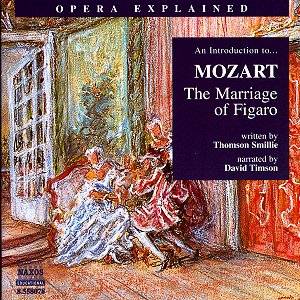Following
directly on from Naxos’s Introduction to … Fidelio (Naxos
Opera Explained 8.558077: link review), here is a layman’s guide
to Mozart’s Le nozze di Figaro. In terms of the operas
themselves, comedy and farce in Mozart replace Beethoven’s high
hymn to humanity. As in the case of the Beethoven, Naxos naturally
uses its own recording for quotes (soloists with the Hungarian
State Opera Orchestra conducted by Pier Giorgio Morandi) and,
also as previously, this makes for a musically satisfactory arrangement.
Seeing
Figaro in its broader context is a commendable, but not
necessarily simple, undertaking, and so it is fitting that the
‘Background’ section of the disc (i.e. before we get to detailed
discussion of the opera itself) takes up nearly 32 minutes of
the total of 80. Tracing Mozart’s operatic trajectory is a fascinating
journey, along the way taking in excerpts from Ascanio in Alba,
Entführung, and on to Zauberflöte. Of
course, Figaro is further contextualised within the sphere
of da Ponte (with Don Giovanni and Così fan tutte),
Beaumarchais and Rossini’s Barber: characters and their
functions in the latter are effectively compared and contrasted.
As
for the opera proper, it is a tribute to the care with which the
spoken text has been assembled that the complexities of plot (which
do appear more graspable when one sees the opera, but can so easily
sound convoluted when one tries to explain them) come across as
plainly and clearly as possible. An admission of this difficulty
(‘only God and Mozart have ever followed exactly what happens
in Act 4’) is touching in its honesty. Carefully chosen musical
quotes from the opera help throughout, and will surely act as
musical signposts when the novice actually listens to Figaro
in toto (or, best of all, sees a production).
As
a promotional tool for the full opera set, this Introduction
fulfils its remit perfectly. There is something of interest for
just about everybody, even those who may think they know the opera,
its genesis and its context inside out.
Colin
Clarke

 Written by Thomson Smillie; Narrated by David Timson
Written by Thomson Smillie; Narrated by David Timson NAXOS OPERA EXPLAINED 8.558078 [79’34]
NAXOS OPERA EXPLAINED 8.558078 [79’34]  Written by Thomson Smillie; Narrated by David Timson
Written by Thomson Smillie; Narrated by David Timson NAXOS OPERA EXPLAINED 8.558078 [79’34]
NAXOS OPERA EXPLAINED 8.558078 [79’34]